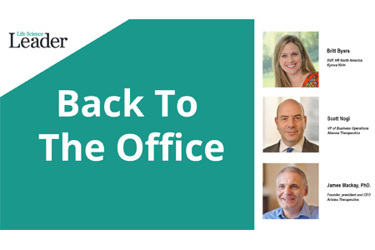When Will Biopharma Be Back In The Office?

By Rob Wright, Chief Editor, Life Science Leader
Follow Me On Twitter @RfwrightLSL

Since the lockdowns began in mid-March 2020, remote work became the new norm for many. And along with that came a new perspective. From the boardroom to entry-level positions, knowledge workers suddenly saw their work and personal lives in a new light. More than a year later, we hear this rallying cry that it’s time to get back into the office. While some companies are opting to be fully remote, others are implementing hybrid models. And despite the rise in COVID-19 cases driven by the Delta variant, there are still others championing for 100% of their people to be back in the office. What is the right answer for companies and employees seems to vary widely. To that end, Life Science Leader hosted an executive virtual roundtable (EVR) on July 28, 2021 (you can listen or watch on our website here) to gain a variety of perspectives. Participants included Britt Byers, SVP, HR North America, Kyowa Kirin; Scott Nogi, VP of business operations, Abeona Therapeutics; and James Mackay, Ph.D., founder, president and CEO, Aristea Therapeutics. What follows is an edited transcript of our conversation.
How Is Kyowa Kirin Getting Back To The Office In The U.S.?

What Tools Were Used In Determining When To Go Back To The Office?
Byers (Kyowa Kirin): In addition to employee surveys, we leveraged a couple of different inputs inside and outside our organization, as Kyowa Kirin operates in different countries and regions around the world. For example, we shared with our executive committee some statistics as to what’s happening from a safety perspective, as well as what’s happening with other employers. In addition, we have a group of employees we refer to as cultural ambassadors. These people work with us on a regular basis for many initiatives, such as work-life balance, onboarding culture, and engagement activities to help shape and inform our ways of working.
How Is A Company Based In New York City Planning For Getting Back To The Office?

When Is Abeona Therapeutics Planning To Return To The Office?
Nogi (Abeona Therapeutics): We communicated to our staff that we were going to be making an announcement pre-September, and were getting ready to go ahead with that, but in light of the activities of the last 48 hours (i.e., the CDC releasing new masking guidance based on infection rates in a localized population), we’re taking a pause to re-evaluate. Our manufacturing facility has been online since June of last year, and other people have been in the office for certain roles and in certain global locations this entire time. Still others haven’t been into a facility in close to 18 months. When to return to the office seems a very individualized choice, and so we are trying to figure out how to manage that across our workforce. To be sure, there is an equity component. For example, if you’re working in the labs, it is hard to deal with bioreactors from your home/apartment. Inventory control must be controlled with specific guidance, which can’t be done remotely like some of our other roles. Being able to evaluate how best to address these situations requires frank conversations, either one-on-one or in town halls with the company, along with the review of employee surveys.
How Does A Biotech CEO Approach Getting Back To The Office?

Nogi (Abeona Therapeutics): We’ve been very communicative in this dynamic situation because obviously, people want to be able to plan their lives, and as we’ve recently seen, that can change in a second. We’ve always stressed with our employee base that this is how it looks right now, and tomorrow it could be different.
Mackay (Aristea Therapeutics): It’s very important that we make sure employees understand that this is a dynamic situation, and that we are going to react to the information in front of us. If that means we say one thing today, and say something completely different tomorrow, that’s okay, and there’s a good reason for it. One of the most important things for leaders is that if new information comes along, you should be prepared to stand up and change your mind about what was said previously, and explain the new information that has resulted in you changing your mind.
Byers (Kyowa Kirin): We just had a town hall, and we said, “This is what we are outlining for the plan, and we will absolutely move and pivot, and there will be more communications.” In this era where things are changing all the time, we are trying to give employees as much advance notice as possible. For example, we tried to give employees one to two months’ notice, which I think they appreciate. In an evolving situation, more communication is better when it comes to developing employee trust. While this takes more effort, it is time well spent.
Mackay (Aristea Therapeutics): We have to create an environment where it’s okay for the employee to say, “I’m uncomfortable with this,” because we’ve all approached this in different ways. We’re all going to have to learn how to socially interact with each other again. People have different tolerances for what they want to do. I’m a great believer in saying to people that there are no right or wrong answers here. It’s whatever you feel is right for you, and you need to be able to express that. There’s certainly no one size fits all here.
Nogi (Abeona Therapeutics): We did an employee survey recently to prepare for the planning and announcing of what our back to office work plan would be. Based on the results, it was clear that there were diverse opinions about protocols, safety, vaccinations, and concerns about social distancing. When walking around at our Cleveland facility, someone would always stop me in the hallway and ask either, “You’re not about to remove the mask mandate are you,” or, “Why haven’t you removed the mask mandate?” From my perspective, the conversation must lean toward being a company policy. If you want to continue wearing a mask when you no longer need to, that decision is going to be well-respected. We are less lenient toward not wearing a mask when it has been mandated.
Mackay (Aristea Therapeutics): The mask mandate is a good example. Just because there’s not a mask mandate anymore doesn’t mean you can’t wear a mask. Even before COVID-19, we saw a lot of people in Asia wear masks when they had a bad cold.
What Are Your Thoughts Regarding CEOs Mandating All Employees Return To In-Office Operations?
Byers (Kyowa Kirin): When you give a short period of notice and push in some direction with whatever guidelines you set, you could be putting yourself in a bit of a box … so you better understand what’s top of mind for employees, and how a hard-and-firm decision to return to the office might impact productivity. Hopefully, any return to the office is being done with a full understanding of the balance between the needs of the employees and business. We should all be moving forward with the best intentions and be open to flexing. If you go into something with a [firm plan], it’s hard to step back and say, “Well, now we are doing something different.” But if you go in with a communication that indicates, here’s where we are today, and this is what we’re looking to do, and it’s well-informed, it allows you to be a bit more flexible.
Mackay (Aristea Therapeutics): I don’t think things will likely ever get back to or be the same as they were before COVID. We’ve seen staff be very vocal about what it is that they want in terms of the flexibility they have at work. And if you take a very strong position, like some CEOs have done regarding returning to the office — and there may be good reasons for doing so — I expect they will see attrition of staff to places where there is more flexibility. This is not to say that a mandated decision to return to the office is wrong. It’s just that people will have a personal choice to make about whether they want to work in that culture/environment.
Nogi (Abeona Therapeutics): Employee reaction and competition for talent have been part of the COVID conversation from the beginning. There are those who are thriving in remote work. And there are those who are failing at remote work. What is the company doing to support those people? Drawing a line in the sand denoting that you are going to be an in-person culture will lead to some attrition. But it may also lead to some people saying that they don’t want to work at some other company.
What Are Your Thoughts Regarding Apple’s Announcement To Postpone Returning To The Office?
Nogi (Abeona Therapeutics): Apple was looking to return to the office in September, which has since been pushed back to October. Somewhere I read that Apple promised employees they’d provide at least a month’s advanced notice, which I think is prudent given our ever-changing situation. For example, I think we all felt strongly that things were heading in a positive direction, and yet were all caught by surprise by the CDC recently changing its masking guidance. Then there is the spread of the Delta variant, which seemed like maybe it was happening in areas with extremely high unvaccinated populations. As new data comes in, you must be able to change the policy accordingly. For a company like Apple, which has many more employees than we have, a much larger office space, and retail and corporate employees, I’m sure they’re figuring out some combination of hybrid in-person and remote work.
Mackay (Aristea Therapeutics): It was a very prudent move by Apple, and as we are considering our back-to-work plans, it wouldn’t surprise me if we do something similar given the way things are changing. It is clear the vaccines have been incredibly effective in preventing serious disease, hospitalization, and death. But we must remember: They don’t actually stop you from catching COVID-19, and there is still a lot we don’t know about this virus. Members of my team who are fully vaccinated still don’t want to catch COVID-19, because they don’t know the long-term side effects of being exposed to the virus. That raises the bar, in terms of when people may feel comfortable coming back in, and I can see other companies taking a similar approach to Apple.
Does Back To The Office Also Mean Getting Back To Traveling To Conferences?
Nogi (Abeona Therapeutics): For us, in very small doses and very small groups, we’ve begun doing some business travel between New York and Cleveland to reconnect the teams. In the beginning, there were policies about who can travel and what tests they had to have available.
As things have lightened up, we always follow CDC recommendations, so that’s made things a little bit easier, especially for our fully vaccinated employees. In terms of conferences. I think most of those have been virtual for us. I am aware of small teams traveling, not for conferences, but maybe for trainings at certain locations. Again, there’s a lot of policy and planning that goes into making that possible.
Mackay (Aristea Therapeutics): It’s a conversation we haven’t even embarked on yet. The team wants to get to a decision about what we’re going to do in the office first, before deciding if we’re going to jump on a plane again. Inevitably we will go back, but a lot of the conferences seem to be thinking about hybrid approaches, where there’ll be in-person activities, but also virtual activities. Certainly, for J.P. Morgan and Biotech Showcase, it was much more efficient this year to meet with people on Zoom, you could pack a lot more meetings in, and it wasn’t so exhausting. Again, there are things there that we’ve learned that need to be built into conferences going forward.
Byers (Kyowa Kirin): We opened for domestic travel only, not international. It was primarily for our field-based teams with geographically large territories, and it’s completely voluntary. Nothing yet on conferences. In fact, we just talked about a meeting that was going to happen internally with a field-based team in a particular geography, and in light of the recent news, have suggested that it not take place. When people do get on a plane and travel, when they come back into their home state, whatever guidelines and protocols apply, they will have to follow those.
Are There Bellwether Companies You Are Watching For Guidance, Or Other Resources Being Applied In Your Back-To-The-Office Decision?
Nogi (Abeona Therapeutics): In terms of bellwether companies, when this started back in February and March of last year, some of the first hints of companies making corporate changes came from some contacts I had at Google. As we started to discuss internally, the answer was, “We’re not a tech company. We don’t operate in the same way. We’re don’t have the same business model. We don’t have the same internal systems and policies.” We were not dismissive, but it’s just a different animal. Then the rest of the world quickly realized this was coming to all industries globally, and we would have to be able to adjust. We’ve been very specific regarding the decision about what’s best for Abeona, and what’s best for keeping our employees safe. By keeping our employees safe, we keep our patients safe, and all our various other stakeholders. That is the key driver for us. But we do use industry surveys, personal contacts at other companies, outreach, and advice from risk management. We don’t want to find ourselves as the only biotech company in biotech doing something. In terms of guidance, the CDC certainly is at the top of the list. But during the crisis period, I was following the OH department of health, the New York state department of health, the New York City department of health, and the health ministry in Madrid, Spain.
You would get various recommendations on a local level. Then we would have to discuss what works across the entire company versus what needed to be applied at a specific level for just that area. It was a struggle; it involved daily conference meetings with our internal COVID response committees.
Mackay (Aristea Therapeutics): From our perspective, being a life science company based in California, we’ve got a huge advantage in terms of the work Biocom California has done. My colleague, Tim Scott, headed up the COVID task force for Biocom from the very beginning. That task force has gone through various phases. They’ve provided a lot of information on testing, how to help people who are remote working, and defining back-to-work approaches for lab-based manufacturing and so on. That task force has done a fantastic job in pulling together all the disparate information and synthesized it into a handbook that anybody can probably access on the Biocom California website.
Byers (Kyowa Kirin): There’s added complexity with a field-based team, given what’s going on at the state level… we obviously had a huge variation. I think this is part of the reason why we stayed in a voluntary return-to-work phase for such a long period of time, as there was a lot to keep up with. Certainly, we leveraged outside counsel. We leveraged other forums, such as BioNJ, and talked to small biotechs and Big Pharma. We also have a COVID steering committee that operates with different areas of expertise. The feeling of being overwhelmed with data and the variations in what was being done, certainly puts you in a position of having a lot of things at your fingertips, but then needing to also step back and say, “If five like-sized companies are doing this, that still may not be right for us, so what do we feel is most comfortable and safe?” Also, inviting the conversation with our field team on a regular basis has been hugely helpful. There are weekly calls with HR and legal representatives to hear what the field reps are experiencing, which helps to shape and inform decision making.
Will Employers Require Employees To Be Vaccinated For COVID-19?
Mackay (Aristea Therapeutics): It’s a very tricky situation. At a minimum, you’re going to see employers want to know the vaccination status of their employees. That’s important because that dictates the risk level that you’re creating in the work environment. Already, we’ve seen some big companies say, “If you’re not vaccinated, you can still work for us, but you’re not coming back into the office.” That’s a risk management judgment. I think they’ll mandate COVID-19 vaccinations for people coming into the facilities.
Nogi (Abeona Therapeutics): This was just a recent topic in the news, where the department of justice (DOJ) came out saying that at this point you could begin to mandate certain vaccinations. You saw it in New York City, where they put in place vaccine mandates or require weekly COVID testing. I believe there was something similarly done in CA. I’ve heard news that with that DOJ announcement and these city and state governments mandating vaccinations, that companies are considering doing the same thing.
Byers (Kyowa Kirin): Our labs have been open, so we’ve had some experience with testing. Mandating vaccinations, if we do move in that direction, makes a lot of sense for certain jobs. For example, you could argue that with field-based individuals, if institutions start to require it to enter a facility — which there is already a credentialing process — then a field-based employee may be required to get a vaccination to be able to do their job. Mandating vaccinations could be role specific. In addition, even if we do mandate vaccinations, there are certain accommodations that we would need to consider for individuals who might have a medical exemption or religious accommodation. To date, most of the testing has been paid for by employers. It may behoove us to consider continuing to fund testing, even if mandating vaccines because the testing of those exempt employees is for the benefit and safety of all employees. Further, there may be visitors coming into your facility. There are a lot of unknowns we haven’t solved for.
Nogi (Abeona Therapeutics): Regarding the visitor comment. When you run a manufacturing facility and labs, there’s maintenance that needs to happen. There are very specific controls that need to be monitored and managed. I was just thinking about all the various policies we have specifically for visitors and the steps that it takes to get someone into the campus that comes from outside the company,
Is Employee Mental Health/Wellness On Your Radar As You Get Back To The Office?
Byers (Kyowa Kirin): It’s been on our minds before returning to the office. When we think about the pandemic, that was a spike in general for mental health. People were dealing with feelings of isolation, uncertainty, anxiety, and depression, which is not unlike pre-pandemic, but was certainly exacerbated. Coming into this current year, we did a lot of work for May, which was mental health awareness month, to bring in mental health experts, to host sessions with employees, which were well attended and offered up additional resources. We offered a mental health recovery day for all employees, including field and lab. That was offered right before the Memorial Day weekend, as we acknowledged the importance of the need to recharge. In addition, we instituted summer hours again, but also “Fri-yay,” which is what we’ve named Friday, in our effort to make Friday afternoons meeting-free so you have a chance to be off Zoom and get caught up before the weekend. We’ve done all those things because people are exhausted. We are certainly worried about burnout, as employees are not only doing their jobs in a different way, but they are caring for others around them in new and multifaceted ways that come with additional constraints - causing angst and concern for their general wellbeing. As an employer, we need to demonstrate that we are listening and responding with changes in our work environment that make things better.
Nogi (Abeona Therapeutics): Mental wellness has been a top-of-mind concern for Abeona since the start of the pandemic, as being aware that everyone’s experience was very different, whether it was burnout, depression, or isolation. I was in a tight New York City apartment with a family of four. That was very different from maybe someone I was speaking with who was completely alone in their environment. We, like many companies, would try to do virtual happy hours, which were well received in the beginning, and then became exhausting as they went on. But we had culture channels built into various communication forums, where it didn’t necessarily have to be about business. At the peak of the pandemic, people were sharing recipes or home videos of the silly things they were doing under lockdown. We haven’t instituted a mental health day for the whole company, though I do like that idea.
Mackay (Aristea Therapeutics): We always had the flexibility on Fridays, as we’ve found that very important after what can be a very intense four days. We try not to have any meetings on a Friday at all, and most people pack up at lunchtime to extend the weekend, which makes a big difference. Mental health was important before COVID. It became very important during COVID. And people like these top female athletes who are talking openly about mental health (e.g., Naomi Osaka, Simone Biles) are a good thing. It does still have some taboo, and people are not prepared to talk about it because of the stigma that they will be considered weak. The worst thing somebody can do if they’ve got a mental health problem is to not talk about it.
Any Parting Pearls Of Wisdom?
Mackay (Aristea Therapeutics): As a leader, it’s important that you really care for the people that you work with. I find, that if you give those people true flexibility, then they give you true flexibility back. From this you can create an environment where you never need to ask somebody to do something, because they already know it needs to be done, and they’ll do whatever is required to do it. In return, they know when they need flexibility from you, they’ll get it. To me, that is a positive culture and environment to work in.
Nogi (Abeona Therapeutics): This is a dynamic situation. You need to listen to your employees. You also need to trust your employees and know that everyone is in this for the right reasons. Everyone has concerns that are valid. There are ways to address all of that, including the stakeholders of the company, the employees, the investors, and most importantly, the patients and their families. It requires very active listening.
Byers (Kyowa Kirin): Listening with an open mind and being curious, because sometimes in these situations you can feel high pressure. There are a lot of things happening, and as a result, there is a feeling of a need to respond quickly. We need to pause and be open to the exchange. Let’s trust our employees and leverage information from all channels,, because you want to have as much as you can at your fingertips. It’s okay to say something, and then a day later revert back based on new information, as long as you are always being open and honest in your communications.
